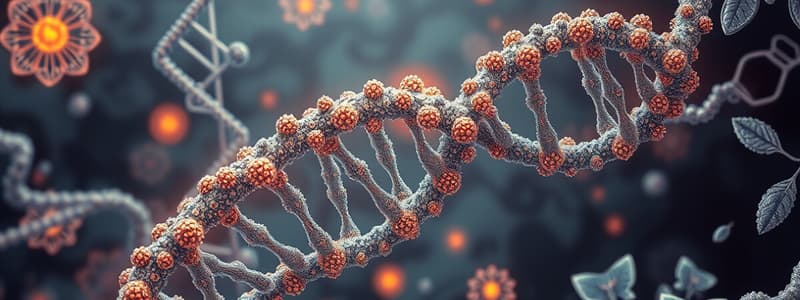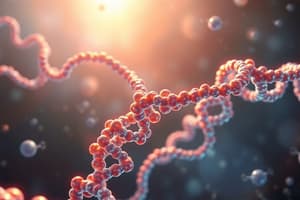Podcast
Questions and Answers
What is the test referred to as in Card 1?
What is the test referred to as in Card 1?
DNA/Biochemistry Test
On which macromolecules does pepsin act?
On which macromolecules does pepsin act?
- Carbohydrate
- Protein (correct)
- DNA
- Lipid
Why does the egg white turn from clear to white when you fry an egg?
Why does the egg white turn from clear to white when you fry an egg?
- The protein becomes dehydrated.
- The protein acquires tertiary structure.
- The protein becomes denatured. (correct)
- The protein becomes dissociated.
What is the chemical basis for margarine becoming solid?
What is the chemical basis for margarine becoming solid?
Given that lactose is a carbohydrate, what can be said about true milk allergies?
Given that lactose is a carbohydrate, what can be said about true milk allergies?
How does shivering relate to ATP hydrolysis?
How does shivering relate to ATP hydrolysis?
What role is oxygen playing in the process of hemoglobin binding to oxygen?
What role is oxygen playing in the process of hemoglobin binding to oxygen?
To overcome a competitive inhibitor in your reaction, what should you do?
To overcome a competitive inhibitor in your reaction, what should you do?
In your skiing scenario, the hill is analogous to what?
In your skiing scenario, the hill is analogous to what?
In noncompetitive inhibitor enzyme inhibition, what does the antibiotic bind to?
In noncompetitive inhibitor enzyme inhibition, what does the antibiotic bind to?
Nucleic acids are created with what type of bonds?
Nucleic acids are created with what type of bonds?
Flashcards are hidden until you start studying
Study Notes
Digestive Enzymes and Proteins
- Pepsin, a digestive enzyme, operates in the acidic stomach environment to break down peptide bonds specifically in proteins.
Egg Protein Denaturation
- Frying an egg causes the clear egg white (albumin) to turn white due to denaturation, where heat alters the protein's structure.
Margarine Production
- Hydrogenation of vegetable oils transforms unsaturated fats into saturated fats, which solidifies margarine, giving it a butter-like consistency.
Lactose Intolerance vs. Milk Allergy
- People with lactose intolerance can typically consume cheese and yogurt, but those with a true milk allergy must avoid all milk products. Lactose is a carbohydrate, not a protein, and does not cause allergic reactions.
Muscle Contraction and ATP Hydrolysis
- Shivering, a response to cold, involves muscle contractions that require ATP hydrolysis, converting energy into heat to raise body temperature.
Hemoglobin and Oxygen Affinity
- Hemoglobin, a tetrameric protein, shows increased oxygen affinity for its remaining subunits when one O2 molecule binds, indicating oxygen acts as an allosteric activator.
Overcoming Competitive Inhibition
- In experiments with competitive inhibition, increasing the concentration of the correct substrate can effectively overcome the inhibitor's effects.
Activation Energy Analogy
- When skiing uphill before going downhill, the incline represents activation energy, which is the energy required to initiate a reaction or movement.
Non-Competitive Inhibition by Antibiotics
- A noncompetitive inhibitor antibiotic functions by binding to the enzyme itself, altering its shape and reducing its activity, regardless of substrate concentration.
Formation of Nucleic Acids
- Nucleic acids, such as DNA and RNA, are constructed using phosphodiester bonds, which link nucleotides together.
Studying That Suits You
Use AI to generate personalized quizzes and flashcards to suit your learning preferences.



